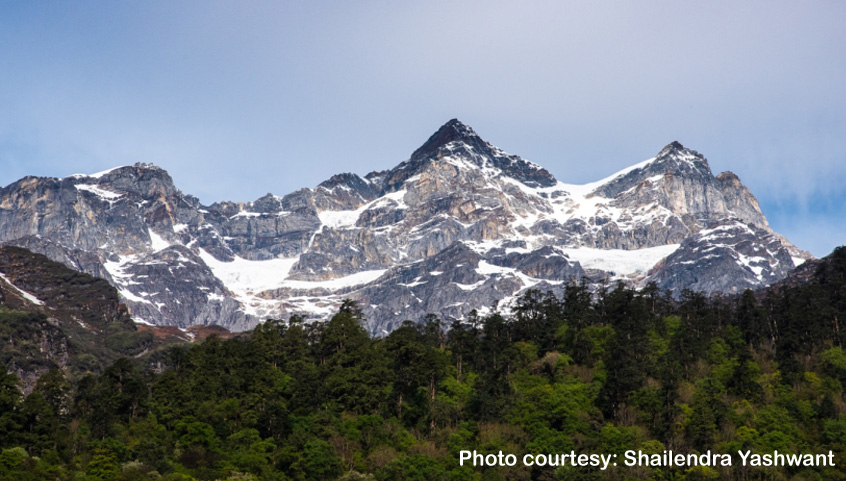Climate Change Impacts on the Himalayas and Community Solutions in South Asia
By Purnima Joshi

The greater Himalayan region’s vast glaciers and permafrost are crucial for ten major Asian rivers, supporting over 1.3 billion livelihoods. The Intergovernmental Panel on Climate Change (IPCC) has confirmed significant snow cover and glacier declines since the 1970s, with further reductions expected. These impacts are already being seen, with glacial retreat, water scarcity, biodiversity loss, and natural disasters such as floods, landslides, and droughts threatening the fragile ecosystems of the region and the livelihoods of millions who depend on it.
The #Himalayas, often referred to as the “Third Pole,” are inherently vulnerable to heavy rains, flash floods, landslides, and other hazards due to being new mountains that are still growing and are seismically active. Climate change has exacerbated this vulnerability, acting as a force multiplier and making natural disasters more severe. The rapid reduction in glaciers, in particular, has profound implications for downstream water resources and the region’s environment.
Warming has surpassed the global average, particularly in Nepal, where extreme weather events like hailstorms, floods, landslides, and droughts are increasingly common. Climate-induced migrations are rising, leading to losses in human life, crops, and infrastructure. These impacts are superimposed on a variety of other environmental and social stresses, many of which are already severe. Human interventions such as dams, hydropower projects, highways, mining, deforestation, buildings, unregulated tourism, and pilgrimage have further increased the fragility of the mountains.
A report produced by CANSA with AirClim, ‘Climate Change: A Himalayan Odyssey’ draws on the extensive research already conducted on climate change and its impact in the Himalayas across countries, and reiterates the climate change risks in light of the last #IPCC AR6 report. It explores ways for regional cooperation among countries in the Himalayas to address climate change, among states and among non-state actors. This report – whose breathtakingly beautiful visuals of the Himalayas juxtaposed against some deeply distressing visuals of the devastation – examines the shared impacts across various sectors and the limitations of previous measures and provides various recommendations on avenues for future regional cooperation.
Community Solutions in South Asia
While countries in the region struggle to come together, highly vulnerable communities living on the frontlines of climate change impacts in the Himalayan region, are finding their own innovative solutions to adapt to and combat climate change disasters. Their efforts are a great example in building local community resilience; some examples include: (1) Community-Based Adaptation: where many communities have adopted practices such as rainwater harvesting, sustainable agriculture, and forest conservation to adapt to changing climatic conditions and ensure food security. (2) Renewable Energy: using renewable energy sources such as solar and wind power in the region, which reduces greenhouse gas emissions and also enhances energy security in remote areas. (3) Ecosystem Conservation: to conserve and restore ecosystems such as forests, wetlands, and grasslands, which play a crucial role in regulating the local climate and providing ecosystem services. (4) Traditional Knowledge: that indigenous communities in the region have about living in harmony with nature; this knowledge is being integrated into modern climate change adaptation strategies.
Some interesting innovative climate solutions from the Himalayan region have been captured on film, as part of CAN-I’s World We Want project. They highlight the importance of community-led solutions and the need for greater support and collaboration to address the impacts of climate change on the Himalayas and beyond.
They are as follows:
- Early Warning Systems in Nepal: The floods in Nepal take at least 175 lives every year, with economic losses pegged at USD140 million and damage to assets at 1.4% of GDP. The installation of early warning systems along all river basins has considerably improved the situation, saving many lives and reducing loss and damage to property. https://cansouthasia.net/wp-content/uploads/2023/11/CANSA-EARLY-WARNING-SHORTER-VERSION-1.mp4
- Alternative Livelihoods in Uttarakhand, India: Climate change has severely affected agriculture-based livelihoods in the Himalayan state of Uttarakhand, India. Local communities have responded with resilience and enterprise, resorting to alternate livelihoods such as quail farming, mushroom cultivation, beekeeping, and choosing climate-resilient species. These initiatives not only provide income but also combat future impacts of climate change and reverse the trend of migration from the hills. https://cansouthasia.net/wp-content/uploads/2023/11/CANSA-LIVELIHOOD-SHORTER-VERSION-1.mp4
- Local #WaterConservation in Uttarakhand, India: Depleting water resources in Uttarakhand are causing agriculture and drinking water problems and aggravating forest fires. Local communities have adopted a simple and low-cost method of recharging water sources such as lakes and springs by building trenches. This has solved water shortages for drinking and agriculture and reduced forest fires. https://cansouthasia.net/wp-content/uploads/2023/11/CANSA-WATER-CONSERVATION-SHORTER-VERSION-1.mp4
What Next
While community-led initiatives are small but important steps towards combating climate change, local governments need to support these efforts. More concerted efforts are needed at the national and international levels to save the mighty Himalayas. Governments in the region must implement policies that promote sustainable development, reduce greenhouse gas emissions, and enhance resilience to climate change.
As many of the challenges faced by the Himalayan region are transboundary in nature, regional cooperation is crucial. Collaborative efforts on issues such as water management, biodiversity conservation, and disaster risk reduction can help build a more resilient future for the region. A more holistic and coordinated approach is needed to address the scale of the challenge. Only through collective action can we hope to protect the Himalayas and ensure a sustainable future for generations to come.
By Purnima Joshi , Communications Coordinator , CANSA.
#Himalayas #IPCC #SouthAsia #WaterConservation





